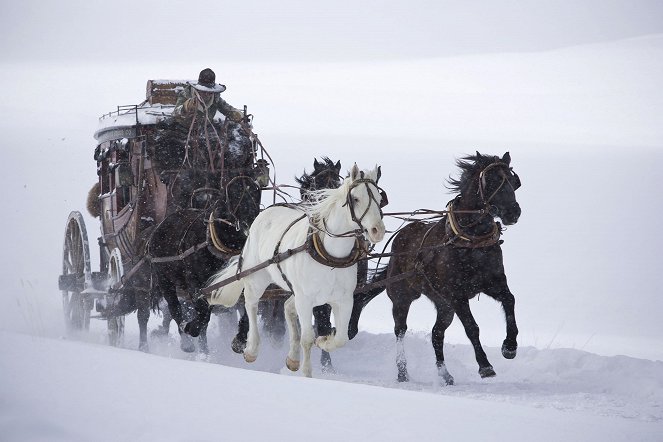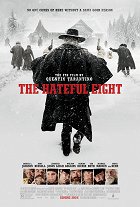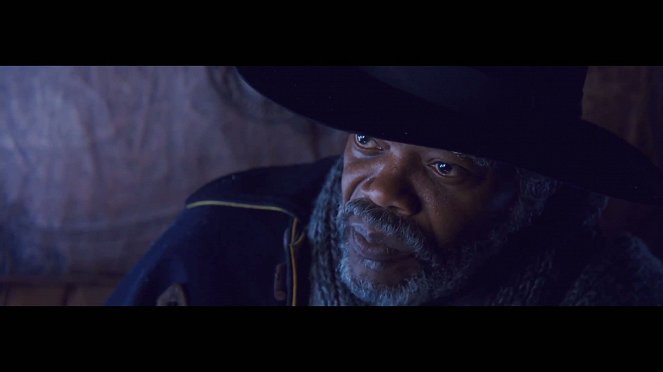Directed by:
Quentin TarantinoScreenplay:
Quentin TarantinoCinematography:
Robert RichardsonComposer:
Ennio MorriconeCast:
Samuel L. Jackson, Kurt Russell, Jennifer Jason Leigh, Walton Goggins, Demián Bichir, Tim Roth, Michael Madsen, Bruce Dern, James Parks, Dana Gourrier (more)VOD (2)
Plots(1)
Six or eight or twelve years after the Civil War, a stagecoach hurtles through the wintry Wyoming landscape. The passengers, bounty hunter John Ruth (Kurt Russell) and his fugitive Daisy Domergue (Jennifer Jason Leigh), race towards the town of Red Rock where Ruth, known in these parts as "The Hangman," will bring Domergue to justice. Along the road, they encounter two strangers: Major Marquis Warren (Samuel L. Jackson), a black former union soldier turned infamous bounty hunter, and Chris Mannix (Walton Goggins), a southern renegade who claims to be the town's new Sheriff. Losing their lead on the blizzard, Ruth, Domergue, Warren and Mannix seek refuge at Minnie's Haberdashery, a stagecoach stopover on a mountain pass. When they arrive at Minnie's, they are greeted not by the proprietor but by four unfamiliar faces. Bob (Demian Bichir), who's taking care of Minnie's while she's visiting her mother, is holed up with Oswaldo Mobray (Tim Roth), the hangman of Red Rock, cow-puncher Joe Gage (Michael Madsen), and Confederate General Sanford Smithers (Bruce Dern). As the storm overtakes the mountainside stopover, our eight travelers come to learn they may not make it to Red Rock after all... (The Weinstein Company)
(more)Videos (28)
Reviews (16)
Tarantino's approach to his film The Hateful Eight can be compared to the intercourse of long-term partners. They know their pleasures, they know what to expect from each other, they have perfected their technique over the years, they no longer rush, and they no longer have anything to prove or fight for. At the same time, it never occurs to them to get rid of their controversial practices, nor do they feel any need to conform to general norms and demands of good manners. With the isolated environment and the limited number of characters who do not trust each other and search for a "weak link" among themselves, the film reminded me of Tarantino's debut. Here and there, the focus is mainly on exposing the characters in a borderline situation. For about 3/4 of the film, we follow eight characters trapped in a cabin in the middle of the mountains, cut off from civilization by a snowstorm. They all have evident and hidden reasons to be on guard, the three-hour duration is filled with dialogues, sometimes seemingly banal, other times punctuated with inappropriateness, vulgarities, and racist remarks. For many viewers, it may be tormenting boredom, but I have no problem with that when it comes to Tarantino. He is too experienced a filmmaker to fill the time with static shots and boredom. He is artistically inventive enough to skillfully dose tension and, from the minimum offered to him, extract the maximum. He can ultimately rely on a strong cast that plays with enthusiasm and considers it an honor to be a part of the film. The actors pay tribute to the cult director, they enjoy it, and lightly overact to highlight mostly the negative characters. The director presents the viewer with a sophisticated cat-and-mouse game but that is where the first stumbling block is hidden. It turns out that the game is somewhat purposeless, or rather does not make much sense, once the resolution is revealed. It is as if the villain tried to break into a house that nobody guards or locks in a convoluted way. The desired result could have been achieved in a much less complicated way, but then it would have been a different film for a different audience. The second problem, which, however, will not bother a large group of Tarantino fans, is the depiction of violence. Violence has always been Tarantino's trademark, and his typical screenwriting and directing feature is the use of violence as a source of humor. On the other hand, in The Hateful Eight, it is clearly evident that Tarantino has not matured. The gratuitousness of certain scenes is striking. A man who has several potential adversaries and should save every bullet that may come in handy for his survival joyfully turns a corpse's head into a bloody mess. Why? Simply because the bloodied floor and tissue remnants all around look impressive. You either deal with this or pick yourself up and move on. Despite the mentioned criticisms, I must say that it is the most likable and interesting Tarantino film since Jackie Brown. Tarantino still has something to offer, and his wild pulp aesthetics, together with the brilliant acting of the cast involved, are worth seeing. Jennifer Jason Leigh deserves a mention. She is already at an age when agents don't often contact Hollywood actresses anymore, and this was an opportunity she did not want to miss. Overall impression: 60%. I have something to add after watching Django Unchained, which I haven't fully digested yet: I have no reason to change my claim that The Hateful Eight is Tarantino's best film since Jackie Brown. However, even this insight does not change the fact that his films are burdened with mannerisms, self-centeredness, and an effort to cater to the presumed expectations of his fans. The long scene where Major Warren vividly describes the execution of a Southern officer's son simply does not deserve a fourth star for its degradation. Tarantino once again proves that he has no limits when it comes to lowering the bar of good taste.
()
(less)
(more)
An almost detective-like Tarantino, with amazing casting at its back moves the genre into entirely uncharted waters (well, snowy hills) while still remaining himself. A well balanced team of actors, headed by Samuel L. Jackson, gives masterful performances, supported by amazing dialogues and catchphrases. The stunning camerawork offers breathtaking sceneries - at times like from another world - and Morricone’s music is gloomy and cold in a way we haven’t heard for a long time. A quality piece. So you’re just starting to imagine it all, right?
()
The Hateful Eight is a great Tarantino revival and, after a long time, a film for which I would not regret paying a higher ticket price (though I’d still rather pay more for a screening from a 70 mm print). Faces familiar from Tarantino’s previous films, a return to the intimate “whodunit” concept of Reservoir Dogs (despite the epic establishing shots and imaginative use of spatial partitioning, which best stand out on the big screen), references to its own universe (Red Apple tobacco), division into chapters (which, in addition to rhythmising the narrative, serve to reveal new information and redirect the viewer’s expectations), the non-chronological organisation of the narrative (which doesn’t break up the film, but contributes to its overall integrity), visual and motif references to spaghetti westerns (Jackson stylised as Lee Van Cleef) and John Ford’s westerns, as well as to (slapstick) splatter flicks and Carpenter’s The Thing, variations on narrative formulas from blaxpoitation and samurai films, not individual scenes but almost the whole film based on waiting (ours and the characters’) for something to happen (and when something finally does happen, there is – in the roadshow version – an intermission followed by a flashback with Godard-esque commentary) and whether it turns out at the end that some of the characters were connected to each other by something other than a chain. The constant delaying of action and the use of dialogue to draw out scenes of simple actions, which the aforementioned Godard enjoyed using to test the patience of his viewers (see the magnificently retarded scene from Breathless with Belmondo and Seberg blabbering in a hotel room) make The Hateful Eight a unique film not only in the context of contemporary Hollywood production, which offers viewer satisfaction much more quickly, but also in Tarantino’s filmography. The first half of the film is not just a sadistically long prelude. The director uses various delaying tactics from beginning to end and even lets the characters provocatively point that out (“Let’s slow it down”). Regardless of the large number of identified (self-)references, this is a masterfully written and acted film in which everything elegantly clicks into place in the end; it just intentionally takes longer than would have been necessary, which would seemingly work as well only as a stage play (the film is aware of its theatrical structure and thematises it with gusto). Most of the characters play a certain role and the film derives much of its tension from the characters/viewers not knowing who is pulling which end of the rope. Though basically everyone is a lying bastard (those who aren’t won’t survive long), your sympathies will constantly shift from one character to the next depending on what Tarantino reveals about them. As much as to the detailed distribution of power (consisting not only in who has a loaded gun in their hand, but also in who knows what – see all of Chapter Four), the film owes its dynamism to the fast-paced dialogue, the energetic acting and camera movements (drawing our attention to important motifs), the lighting, the refocusing, the work with the depth (height and width) of the space and the editing (taking into account who is looking at whom and how). Even more than Django Unchained, The Hateful Eight would like to be a political allegory in the style of the subversive counterculture westerns of the 1970s, using not very sensitive means to draw attention to the parallels between racism and capitalism. The literalness of the film’s ideological level (lines like “When niggers are scared, that’s when white folks are safe”, the division of the bar into individual American states) contrasts with the much more subtle means by which Tarantino builds tension, creates an oppressive atmosphere of distrust and communicates essential information about who is an ally or an enemy. Even so, this is a brilliant allegory that offers very disturbing and not entirely unambiguous commentary on a different interpretation of law and justice. Tarantino has made an extremely nihilistic western that successfully creates the atmosphere of an era in which people are united mainly by their hatred of a common enemy. Primarily, however, it abounds with the narrative skill of the best Agatha Christie novels. I believe that, like Christie’s books, The Hateful Eight will only get better over time. 90%
()
(less)
(more)
Tarantino's Ten Little Blacks... I mean, bad guys in a nearly three-hour intimate snowy movie in a western style. If his plan is still valid, that after ten films he ends up with cinematography and starts with the theater. If so, we have many reasons to feel excited about that. In a same way that the staging department will be since the will be supposed to clean the stage from tons of blood after every performance. And although I have some fundamental reservations about the way it is built in the Eighth (and that it is almost a repetition of the fourth chapter of the Inglourious Basterds) and the tension between the characters should have been even bigger, but on the other hand, brilliant dialogs and cast were flawless. And as a fan of Goggins, I appreciate how he seized the opportunity when someone finally gave him adequate space in the film.
()
A self-indulgent massage of the creative ego, which has grown to manic proportions in the use of epic cinematic toys (Ennio, 70 mm, Nicoreto), all whilst covering itself for three hours with a banal story that commits obscure suicide in the form of the chapter "Earlier that morning," destroying the last vestiges of credibility. The much-maligned first hour is in no way useless, and the snow rascals couldn't have gotten better casting (all of them amazing, but Goggins' Mannix undergoes the most interesting evolution of audience sympathy). Thus, even if common sense starts to politely resist it after all the grand circles, Tarantino proves again how cheap of a whore the audience can be at times and gets hooked by banalities we'd long ago boo others for. If, in the end, you accept the fact that the absence of Quentin's traditional absurdist humor is actually a good thing, you're going to like the film. 4 ½.
()
Gallery (77)
Photo © The Weinstein Company


